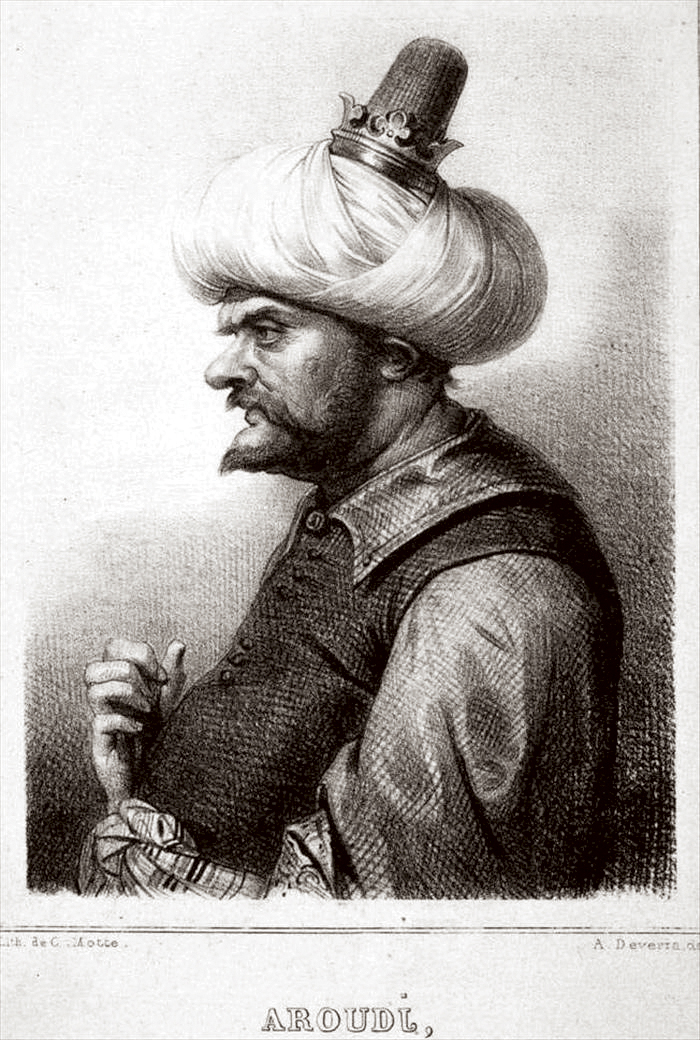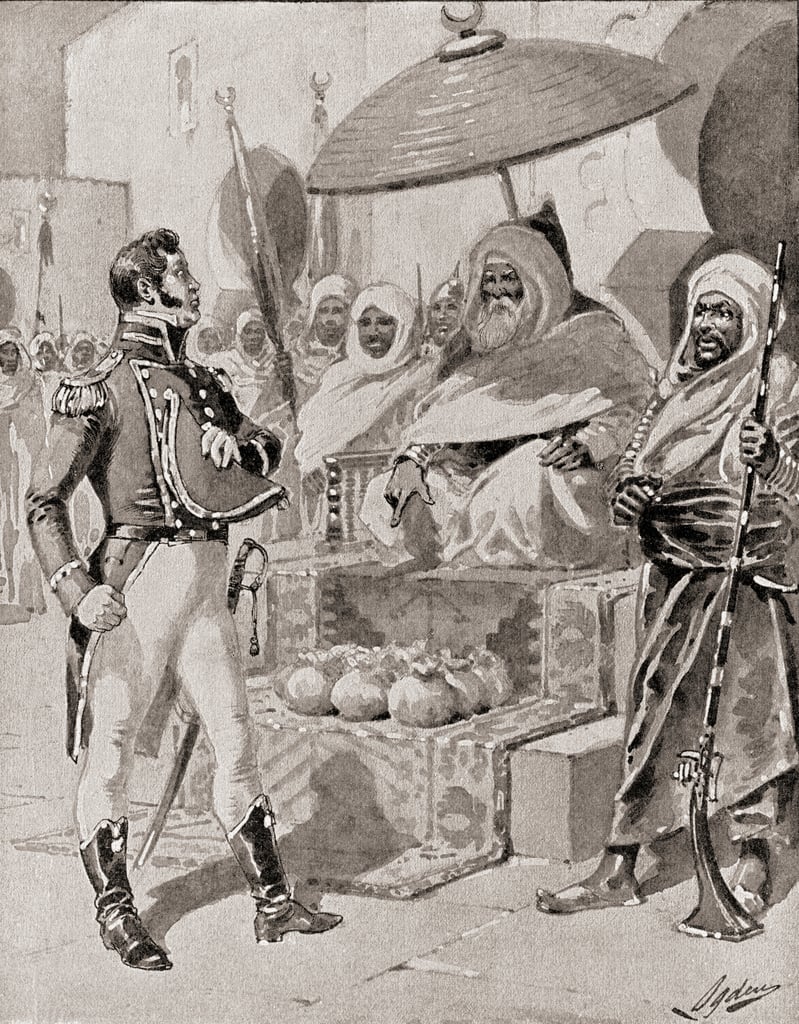|
Dey
Dey (, from ) was the title given to the rulers of the regencies of Algiers, Tripolitania,Bertarelli (1929), p. 203. and Tunis under the Ottoman Empire from 1671 onwards. Twenty-nine ''deys'' held office from the establishment of the deylicate in Algeria until the French conquest in 1830. The dey was chosen by local civilian, military, and religious leaders to govern for life and ruled with a high degree of autonomy from the Ottoman sultan. The main sources of his revenues were taxes on the agricultural population, religious tributes, and protection payments rendered by Corsairs, regarded as pirates who preyed on Mediterranean shipping. In the European part of the Ottoman Empire, in particular during its decline, leaders of the outlawed janissary and yamak troops sometimes acquired title of Dahi or Dahia, which is derived from Dey. The dey was assisted in governing made up of the Chiefs of the Army and Navy, the Director of Shipping, the Treasurer-General and the Collector o ... [...More Info...] [...Related Items...] OR: [Wikipedia] [Google] [Baidu] [Amazon] |
Regency Of Algiers
The Regency of Algiers was an Early modern period, early modern semi-independent Administrative divisions of the Ottoman Empire, Ottoman province and nominal Tributary states of the Ottoman Empire, vassal state on the Barbary Coast of North Africa from 1516 to 1830. Founded by the privateer brothers Aruj Barbarossa, Aruj and Hayreddin Barbarossa, Hayreddin Reis (also known as the Barbarossa brothers), the Regency succeeded the Kingdom of Tlemcen as an infamous and formidable base that waged maritime Religious war, holy war on European Christian powers. Elected regents headed a stratocracy that haunted European imagination for three centuries but still gained recognition as a regional power. The Regency emerged in the 16th-century Ottoman–Habsburg wars. As self-proclaimed gaining popular support and Legitimacy (political), legitimacy from the religious leaders at the expense of hostile local Emir, emirs, the Barbarossa brothers and their successors carved a unique corsair stat ... [...More Info...] [...Related Items...] OR: [Wikipedia] [Google] [Baidu] [Amazon] |
Hussein Dey (ruler)
Hussein Dey (real name Hüseyin bin Hüseyin; 1765–1838; ) was the last Dey of the Deylik of Algiers. Early life He was born either in İzmir or Urla in the Ottoman Empire. He went to Istanbul and joined the Canoneers (Topçular in Turkish), and quickly rose to the rank of Odabaşı, but thanks to his character and rivalries, he was forced to flee the Ottoman Empire. He fled to the Deylik of Algiers, a country which was de facto independent from the Ottoman Empire, similar to the other countries of the Barbary Coast. Algiers was well known for accepting fugitives of different countries. There, he joined the Odjak of Algiers and became a Janissary. In 1815 he was appointed Khodjet al-khil, a minister tasked with raising and commanding the cavalry of the Dey and raising taxes. He commanded the cavalry as a quick relief force during the bombardment of Algiers in 1816. In 1818 following the death of the previous Dey, the Divan of Algiers elected Hussein as the next ruler. ... [...More Info...] [...Related Items...] OR: [Wikipedia] [Google] [Baidu] [Amazon] |
Regency Of Tunis
Ottoman Tunisia, also known as the Regency of Tunis, refers to a territory of Ottoman Empire that existed from the 16th to 19th century in what is largely modern-day Tunisia. During the period of Ottoman Rule, Tunis was administratively integrated into the Ottoman Empire as the Eyalet of Tunis. The Ottoman presence in the Maghreb began with the conquest of Algiers in 1516 by the Ottoman Turkish corsair and ''beylerbey'' Aruj (Oruç Reis). In 1534, the Ottoman navy under the command of Kapudan Pasha Hayreddin Barbarossa, himself the younger brother of Aruj, attacked and successfully captured Tunis, which was then a territory of the Hafsids. However, less than a year later, Emperor Charles V sent a large, multinational invasion force to wrest control of Tunis, which attacked from across the Strait of Sicily and overwhelmed the city's Ottoman defenders. Following the final Ottoman reconquest of Tunis from Spain in 1574, the Ottoman Empire would hold Tunis for over three cent ... [...More Info...] [...Related Items...] OR: [Wikipedia] [Google] [Baidu] [Amazon] |
List Of Pashas And Deys Of Algiers
This is a list of the Beylerbeys, Pashas and Deys of the Regency of Algiers: Beylerbeys of the Regency of Algiers (1517–1588) Pashas (1577–1659) * Dely Ahmed 1586–1589 * Hızır Pasha 1589–1591 * Hadji Shaban Pasha 1591–1593 * Mustapha Pasha 1593–1594 *Kader Pasha (second time) 1594–1595 * Mustapha II Pasha 1596–1599 * Daly Hassan Pasha 1599–1601 * Somiman Pasha 1601–1603 * Muhammad II the eunuch 1605–1607 *Mustapha III Pasha 1607 * Redwan Pasha 1607–1610 * Kussa Mustapha 1610–1614 * Hasan IV 1614–1616 *Mustapha IV Pasha 1616–1619 * Kassan Kaid Kussa 1619–1621 *Kader Pasha 1621–1626 *Hassan Khodja 1626–1634 * Yusuf II 1634–1645 * *Mahmud Brusali Pasha 1645–1647 * Yusef Pasha 1647–1650 * Mehmed Pasha 1650–1653 * Ahmed Pasha (first period of rule) 1653–1655 * Ibrahim Pasha (first period) 1655–1656 * Ahmed Pasha (second period) 1656–1657 * Ibrahim Pasha (second period) 1657–1659 * Ahmed Pasha (third period) 1658–1659 Agha ... [...More Info...] [...Related Items...] OR: [Wikipedia] [Google] [Baidu] [Amazon] |
Casbah Of Algiers
The Casbah of Algiers, commonly referred to as the Casbah (Arabic: القصبة, Al-qaṣabah, meaning "citadel"), corresponds to the old town or Medina quarter, medina of Algiers, the capital of Algeria. It is a historic district that has been listed as a UNESCO World Heritage Site since 1992. Administratively, it is located within the Communes of Algeria, municipality of Kasbah, Casbah, in the Algiers Province, province of Algiers. Likely inhabited since the Neolithic period, as were various sites in the Algiers Sahel, the first mentions of the city date back to Ancient history, Antiquity, when it was initially a Phoenicia, Phoenician port, later becoming Berbers, Berber and eventually Rome, Roman. The current urban framework was designed in the 10th century by the Berbers under the Zirid dynasty, later enriched by contributions from other Berber dynasties that successively ruled the central Maghreb. The Casbah reached its peak during the period of the Regency of Algiers, servin ... [...More Info...] [...Related Items...] OR: [Wikipedia] [Google] [Baidu] [Amazon] |
Barbary Wars
The Barbary Wars were a series of two wars fought by the United States, Sweden, and the Kingdom of Sicily against the Barbary states (including Tunis, Algiers, and Tripoli) and Morocco of North Africa in the early 19th century. Sweden had been at war with the Tripolitans since 1800 and was joined by the newly independent US. The First Barbary War extended from 10 May 1801 to 10 June 1805, with the Second Barbary War lasting only three days, ending on 19 June 1815. The Barbary Wars were the first major American wars fought entirely outside the New World, and in the Arab World. The wars were largely a reaction to piracy by the Barbary states. Since the 16th century, North African pirates had captured ships and even raided European coastal areas across the Mediterranean Sea. Originally starting out with the goal of capturing individuals for the domestic North African slave trade, the focus later shifted to kidnapping for ransom. By the 19th century, pirate activity had decline ... [...More Info...] [...Related Items...] OR: [Wikipedia] [Google] [Baidu] [Amazon] |
Zwawa
Igawawen or Gawawa, mostly known as Zwawa (in Kabyle language, Kabyle: Igawawen, in Arabic: زواوة, and in Latin: Jubaleni''Revue archéologique, Société française d'archéologie classique'' (in French), p. 28) were a group of Kabyle people, Kabyle tribes inhabiting the Djurdjura mountains, Kabylia, Greater Kabylia, in Algeria. The Zouaoua are a branch of the Kutama tribe of the Baranis Berbers.Ibn Khaldun, ''Histoire des Berbères et des dynasties musulmanes de l'Afrique septentrionale'' (in French), Volume 1, Paris, Imprimerie du gouvernement, 1852, 447 p.read online, p. 255 In the most restricted sense, the Igawawen were a confederation (Kabyle language, kabyle: ''taqbilt'', derived from arabic "قبيلة" meaning tribe) of 8 tribes split into two groups: * Ait Betrun: Beni Yenni, Ait Yenni, Ouacifs, At Wasif, Iboudraren, Ait Budrar, Ait Bu Akkash. * Ait Mengellet: Aïn El Hammam, Ait Mengellet ''proper'', Akbil, Ait Aqbil, Yattafène, Ait Attaf, Abi Youcef, Ait Bu Yuse ... [...More Info...] [...Related Items...] OR: [Wikipedia] [Google] [Baidu] [Amazon] |
Ali Khodja
Ali V Ben Ahmed, nicknamed Ali Khodja, Ali-Meguer, or Ali Loco (the mad) (Arabic: علي ابن أحمد خوجة) was a Kouloughli of partial Georgian ( Mengrelian) and Native Algerian origins born in Algeria. He was the dey of the Deylik of Algiers from September 1817, just after the assassination of his predecessor Omar Agha the 8th. He remained so until his death in March 1818. His sobriquet ''Ali-Meguer'' may indicate his Mingrelian background. Early life He was complicit in the assassination of Ahmed bin Ali Khodja in 1808, and the assassination of Omar Agha (1817). He served in various important positions before being elected Dey in 1817. Rule A few days after his arrival, and to better ensure his safety, he left the Djenina Palace located in the lower part of the city of Algiers and offering small defenses to move to the casbah, where he put the treasury safe. Using his connections to the Kabyles, he signed an alliance with the Zwawas, and the Kouloughlis. Afte ... [...More Info...] [...Related Items...] OR: [Wikipedia] [Google] [Baidu] [Amazon] |
Barbary Corsairs
The Barbary corsairs, Barbary pirates, Ottoman corsairs, or naval mujahideen (in Muslim sources) were mainly Muslim corsairs and privateers who operated from the largely independent Barbary states. This area was known in Europe as the Barbary Coast, in reference to the Berbers. Slaves in Barbary could be of many ethnicities, and of many different religions, such as Christian, Jewish, or Muslim. Their predation extended throughout the Mediterranean, south along West Africa's Atlantic seaboard and into the North Atlantic as far north as Turkish Abductions, Iceland, but they primarily operated in the western Mediterranean. In addition to seizing merchant ships, they engaged in ''Razzia (military), razzias'', raids on European coastal towns and villages, mainly in Italy, France, Spain, and Portugal, but also in the British Isles, and Iceland. While such raids began after the Muslim conquest of the Iberian Peninsula in the 710s, the terms "Barbary pirates" and "Barbary corsairs" ... [...More Info...] [...Related Items...] OR: [Wikipedia] [Google] [Baidu] [Amazon] |
Ottoman Empire
The Ottoman Empire (), also called the Turkish Empire, was an empire, imperial realm that controlled much of Southeast Europe, West Asia, and North Africa from the 14th to early 20th centuries; it also controlled parts of southeastern Central Europe, between the early 16th and early 18th centuries. The empire emerged from a Anatolian beyliks, ''beylik'', or principality, founded in northwestern Anatolia in by the Turkoman (ethnonym), Turkoman tribal leader Osman I. His successors Ottoman wars in Europe, conquered much of Anatolia and expanded into the Balkans by the mid-14th century, transforming their petty kingdom into a transcontinental empire. The Ottomans ended the Byzantine Empire with the Fall of Constantinople, conquest of Constantinople in 1453 by Mehmed II. With its capital at History of Istanbul#Ottoman Empire, Constantinople (modern-day Istanbul) and control over a significant portion of the Mediterranean Basin, the Ottoman Empire was at the centre of interacti ... [...More Info...] [...Related Items...] OR: [Wikipedia] [Google] [Baidu] [Amazon] |
Kaftan
A kaftan or caftan (; , ; , ; ) is a variant of the robe or tunic. Originating in Asia, it has been worn by a number of cultures around the world for thousands of years. In Russian usage, ''kaftan'' instead refers to a style of men's long suit with tight sleeves. It may be made of wool, cashmere wool, cashmere, silk, or cotton, and may be worn with a sash. Popular during the time of the Ottoman Empire, detailed and elaborately designed garments were given to ambassadors and other important guests at the Topkapı Palace. Variations of the kaftan were inherited by cultures throughout Asia and were worn by individuals in Russia (North Asia, Eastern Europe and formerly Central Asia), Southwest Asia and Northern Africa. Styles, uses, and names for the kaftan vary from culture to culture. The kaftan is often worn as a Coat (clothing), coat or as an overdress, usually having long sleeves and reaching to the ankles. In regions with a warm climate, it is worn as a light-weight, loose-f ... [...More Info...] [...Related Items...] OR: [Wikipedia] [Google] [Baidu] [Amazon] |
Baig
Bey, also spelled as Baig, Bayg, Beigh, Beig, Bek, Baeg, Begh, or Beg, is a Turkic title for a chieftain, and a royal, aristocratic title traditionally applied to people with special lineages to the leaders or rulers of variously sized areas in the numerous Turkic kingdoms, emirates, sultanates and empires in Central Asia, South Asia, Southeast Europe, and the Middle East, such as the Ottomans, Timurids or the various khanates and emirates in Central Asia and the Eurasian Steppe. The feminine equivalent title was begum. The regions or provinces where "beys" ruled or which they administered were called '' beylik'', roughly meaning "governorate" or "region" (the equivalent of a county, duchy, grand duchy or principality in Europe, depending on the size and importance of the beylik). However the exact scope of power handed to the beys varied with each country, thus there was no clear-cut system, rigidly applied to all countries defining all the possible power and prestige that ... [...More Info...] [...Related Items...] OR: [Wikipedia] [Google] [Baidu] [Amazon] |








